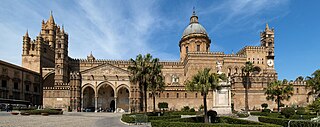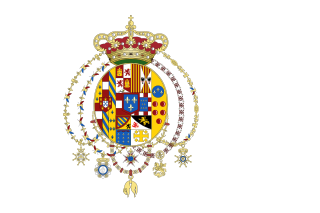
Sicily is the largest island in the Mediterranean Sea and one of the 20 regions of Italy. It is one of the five Italian autonomous regions and is officially referred to as Regione Siciliana. The region has 5 million inhabitants. Its capital city is Palermo.

Palermo is a city of southern Italy, the capital of both the autonomous region of Sicily and the Metropolitan City of Palermo. The city is noted for its history, culture, architecture and gastronomy, playing an important role throughout much of its existence; it is over 2,700 years old. Palermo is in the northwest of the island of Sicily, by the Gulf of Palermo in the Tyrrhenian Sea.

Catania is the second largest city in Sicily, after Palermo, and among the ten largest cities in Italy. Located on Sicily's east coast, it faces the Ionian Sea. It is the capital of the 58-municipality region known as the Metropolitan City of Catania, which is the seventh-largest metropolitan city in Italy. The population of the city proper is 311,584, while the population of the Metropolitan City of Catania is 1,107,702.

Monreale is a town and comune in the Metropolitan City of Palermo, in Sicily, southern Italy. It is located on the slope of Monte Caputo, overlooking the very fertile valley called "La Conca d'oro", a production area of orange, olive and almond trees, the produce of which is exported in large quantities. The town, which has a population of approximately 39,000, is about 7 kilometres inland (south) of Palermo, the regional capital.

The Kingdom of Naples, officially known as the Kingdom of Sicily, comprised the part of the Italian Peninsula south of the Papal States between 1282 and 1816. It was established by the War of the Sicilian Vespers (1282–1302), when the island of Sicily revolted and was conquered by the Crown of Aragon, becoming a separate kingdom also called the Kingdom of Sicily. In 1816, it reunified with the island of Sicily to form the Kingdom of the Two Sicilies.

Southern Italy, also known as Meridione or Mezzogiorno, is a macroregion of Italy consisting of the southern half of the Italian state.

Palermo is one of the major cities of Italy, and the historical and administrative capital of Sicily.

Ferdinando Fuga was an Italian architect who was born in Florence, and is known for his work in Rome and Naples. Much of his early work was in Rome, notably, the Palazzo della Consulta (1732–7) at the Quirinal, the Palazzo Corsini (1736–54), the façade of the Santa Maria Maggiore (1741–3), and the Church of Sant'Apollinare (1742–8). He later moved to Naples and notably designed the Albergo de'Poveri (1751–81), the façade of the Church of the Gerolamini, and that of the Palazzo Giordano.

Palermo Cathedral is the cathedral church of the Roman Catholic Archdiocese of Palermo, located in Palermo, Sicily, southern Italy. It is dedicated to the Assumption of the Virgin Mary. As an architectural complex, it is characterized by the presence of different styles, due to a long history of additions, alterations and restorations, the last of which occurred in the 18th century.

Mount Pellegrino is a hill facing east on the bay of Palermo, Sicily, southern Italy, located north of the city.
The history of the Jews in Sicily deals with Jews and the Jewish community in Sicily which possibly dates back two millennia. Sicily is a large island off the Southern Italian coast. There has been a Jewish presence in Sicily for at least 1400 years and possibly for more than 2000 years.

The Kingdom of the Two Sicilies was a kingdom located in Southern Italy from 1816 to 1860. The kingdom was the largest sovereign state by population and size in Italy prior to Italian unification, comprising Sicily and all of the peninsula of Italy south of the Papal States, covering most of the area of today's Mezzogiorno.

Mondello is a small borough of the city of Palermo in the autonomous region of Sicily in Southern Italy.

The Addaura cave is a complex of three natural grottoes located on the northeast side of Mount Pellegrino in Palermo, Sicily, southern Italy. The importance of the complex is due to the presence of cave-wall engravings dated to the late Epigravettian and the Mesolithic.
Ippodromo della Favorita is a horse racing venue in Palermo, Sicily, Italy built in 1953. It is located next to the Stadio Renzo Barbera in the southernmost part of Parco della Favorita, Palermo's largest urban park.

Notarbartolo is one of the main aristocratic families of the Sicilian nobility. Originated in the Middle Ages, it gave to the island numerous personalities who have made a significant contribution to its social, political, intellectual and artistic life, as well as a mastermind behind a major heist. The different branches of the family collected, over the centuries, numerous fiefdoms and noble titles.

The Chinese Palace, also known as Real Casina alla Cinese, is a former royal residence of the House of Bourbon-Two Sicilies designed in the style of Chinoiserie. It is located in Palermo, inside the park of La Favorita. The Ethnographic Museum of Sicily, named after Giuseppe Pitrè, is located in one of the Palace's guesthouse.

The Maredolce Castle, also called Favara Palace, is a medieval building of Palermo. During the Siculo-Norman age it represented one of the "Solatii Regii" of the Kings of Sicily in the capital city. It is located within Favara Park, in the neighbourhood of Brancaccio.

Ficuzza is a southern Italian village and hamlet (frazione) of Corleone, a municipality in the Metropolitan City of Palermo, Sicily. in 2011 it had a population of 112.

The following outline is provided as an overview of and topical guide to Palermo:



















